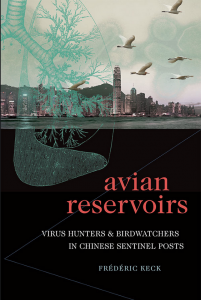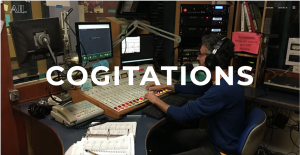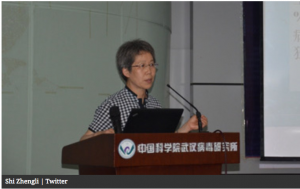Social distancing and human/animal relations

The work of anthropologist Frédéric Keck has become one of the more valuable resources for making sense of the complex underpinnings of the epidemic predicament. Keck’s most recent book Avian Reservoirs. Virus Hunters and Birdwatchers in Chinese Sentinel Posts (for information by its publisher Duke University Press see here, for a free downloadable version of the book go here) is being widely discussed and deservedly ranges among the current must-reads.
I have been made aware of Keck’s book by filmmaker and film curator Stefan Pethke, a former collaborator of Harun Farocki and one of the Harun Farocki Institut’s close allies, who had the book brought to his attention by his cousin Tarek Elhaik. An anthropologist of the image and of aesthetics who bases his work on “intensive participant observation in contemporary art and curatorial worlds,” Elhaik teaches at UC Davis where he also co-runs AIL: The Anthropology of the Image Lab. AIL is both a physical venue located on-campus and an online curatorial platform. To give an idea of how this place is conceived theoretically, a quote from AIL’s “about” page may prove instructive: “The acronym (AIL) designates a form of symptomatology indebted to Gilles Deleuze’s critical and clinical studies and to his understanding of thinking as the study of images of thought. AIL is also indebted to a cluster of concepts introduced by psychoanalyst D.W Winnicott and therefore is a venue that functions as a ‘Potential Space’ and ‘Holding Environment’ where media scholars, curators, artists, and students critically encounter and engage one another without succumbing to the Geertzian imperative of ‘vexing one another.’ […] AIL is an unusual kind of gallery populated by image-workers who cogitate together around a host of conceptual personae: the Architect, the Artist, the Librarian, the Marine Biologist, the Engineer, the Composer, and so forth.”

Tarek Elhaik
The symptomatology or “ailment” that is being observed and treated at AIL thus can be rendered as the condition of the image as a matter of cognition, or rather, Elhaik emphasizes, “cogitation,” a term which is also the title of a series of radio programmes/podcasts he hosts. “Cogitating” with images, concepts and forms, in Elhaik’s understanding, is less a kind of “reflecting” on them and more an “expression of a way of life,” guided by the example of “cogitating” minds such as Averroes and Sun Ra. Seen and practiced thusly, the radio as a medium of sound-based communication and cogitation provides opportunities and entry-points to explore images and the imaginary, for instance as these mutate in times of crisis and states of emergency.
The latest of these cogitative conversations was held with the aforementioned Frédéric Keck, and it turned out to be an exchange in the liminality of “cogitation” and “contagion.”
COGITATION #2 (AIL/Tarek Eilhak) On Avian Reservoirs with Frédéric Keck (April 2020)
Elhaik, true to AIL’s mission, entered the talk with an interest in questions of the imaginability and intelligibility of the pandemic. And having Keck as an interlocutor, looking for points of contact between an anthropology of the visual and a brand of cross-cultural and cross-disciplinary philosophical anthropology, certainly is promising. This said, Keck begins with a succinct summary of some of his book’s main points. Boldly sketching his agenda, Keck explains why he distinguishes between three “P’s” and three “S’s,” in order to trace differences between cultures and societies in living with and fighting an epidemic.
In case you haven’t yet listened to the podcast (and you should!), here are some of the bullet points of Keck’s take on the issues of inter-species relations and behavioral and epistemological patterns that predicate the way in which a health crisis is being managed and calibrated. The three P’s are “preparedness,” “prevention,” and “precaution;” the three S’s are “sentinel,” “stockpiling,” and “simulation.” Keck defines prevention (or securitization) as “the management and control of populations in a territory through the use of statistics,”, whereas preparedness (or mitigating) is said to be “the imaginary enactment of disasters in a community where humans take the perspective of nonhumans.” Precaution then is “a mix between prevention and preparedness, since it is an injunction to protect oneself when the state doesn’t control a defined territory,” something Keck observes, particularly in Europe. In another of his numerous recent interviews, he states that European societies have proven incapable of developing “an intermediary rationality between prevention and preparedness.” Sentinels, simulations, and storage are considered “as cynegetic techniques of preparedness” as opposed to “pastoralist techniques of prevention […] conceived as sacrifice, scenarios, and stockpiling.” This is a complex array of terms, and Keck has honed it thoughtfully to become a sort of organizing backbone or substructure of his far-reaching conceptual approach. Needless to say, it is extremely rewarding to engage with it, as it pertains to fundamental questions of relationality and (inter-)dependence, in particular between humans and animals, so eminently important for the understanding and coping with the pandemic.

Frédéric Keck (photo: Télérama)
In the introduction of Avian Reservoirs Keck asks: “What does it mean to practice preparedness at the animal level? How does it differ from doing it at the human level? What does it change in the relations between humans and other animals? Is there something specifically Asian in the way preparedness has been implemented? And what can we learn about the way Asian societies have practiced preparedness ‘at the avian level’?” Keck studied microbiologists and birdwatchers/ornithologists from an ethnographical-philosophical point of view, focussing on their conceptual practice more than on what they actually do pursuing their respective professions. He recognizes an “alliance” or “complementarity” between them, as both are “using concepts from the anthropology of hunter-gatherers.” He made “their two perspectives on bird flu and their difference with other actors of pandemic preparedness” the object of his research. A guiding question for him became: “How is the imperative to be prepared for an influenza pandemic embedded in the practices of microbiologists and birdwatchers when they see relations between humans and birds through the pathogens they share in common?” The crucial parallel between microbiologists and ornithologists is thus their interest in the perspective on the environment of the animal or virus they are “hunting.” Rather than aiming at “killing” the bird (which would be preventive of a possible avian flu), birdwatchers prepare by identifying with its perception. Considering prevention and preparation “as concepts and not just as techniques,” Keck generalizes them “as modes of relations between humans and their environment […]”; furthermore, he borrows from them “concepts of myth, ritual, and exchange” that he uses “to describe contemporary techniques of preparedness.”
Keck brings social anthropology to the conversation of the experts who seek for explanations and solutions of the current condition. In this he follows a tradition of the Laboratoire d’anthropologie sociale at the Collège de France, founded by Claude Lévi-Strauss in 1960. As Keck elaborates in another interview, his interest is in the way in which different societies – in their relationships of state and population, the rural and the urban, the wild and the domesticated – are currently being “recomposed” by the global phenomenon of Covid-19. “My analysis of the current situation is that all the states are bragging about, saying, ‘Look, we can deal with the virus.’ They are putting increasingly expensive containment measures in place, tracing techniques that you would never have dared to dream of in the most totalitarian societies. But in fact, these are all signals sent both to people who are a little flabbergasted and to the virus itself, to tell it ‘go ahead, keep going, we are not afraid.’ I’d propose rather than getting into this slightly competitive game, which is completely neoliberal – and a bit childish – we should see it more as a dance of humans with animals and microbes. This is a somewhat awkward moment in which we are learning to live with the coronavirus. […] I think you have to become an adult in dealing with viruses. We really need to understand the messages they are sending us rather than once again considering them as enemies against whom we are going to puff up and win points by showing the decrease in the number of deaths and the decrease in growth points.”
Towards the end of the AIL podcast, Keck makes a crucial point when he makes clear that nature and animals send pathogens because humans are trying to control them in inappropriate and endangering ways. Mitigation thus needs to be re-thought, Keck claims: rather than as a lowering of casualties and infection rates it should be conceived as a sort of “coping with the contradictions of a pastoralist mode of being that distances us from the animals.” In other words, turning animals into livestock or cattle is where the problem starts.
Somewhat obliquely, yet eventually effectively responding to Elhaik’s questions about the phenomenological and perceptual dimensions of his research on sentinels and virologists (who he distinguishes from epidemiologists, likening them to hunter-gatherers instead of the epidemiologists with their “pastoralist” stance), the fellow anthropologist speaks emphatically about how the “interiority” of the bird/bat (and by consequence the virus) becomes the place or perspective that needs to be inhabited, in order to reach at a culture of preparedness that would actually alter the relationship to the virus.


Shi Zhengli
Featuring in the bibliography of Keck’s book is a 2008 virological paper co-authored by Shi Zhengli, on “animal reservoirs of the SARS coronavirus.” Shi, arguably one of the most important researchers on the coronavirus since the outbreak of SARS in 2003, has built a large database of bat-related viruses. Currently known as the “bat woman” she has been profiled in Scientific American, with a particularly revealing account of her discovery of the SARS-infected bats during numerous cave expeditions. It is worth quoting at length the story of the virologist’s itinerary, beginning in 2004 and leading to her present status of a key coronavirus authority, as it talks of (and often deploying the respective language – “to hunt down the viral genomic sequences”) the specific hunter-gatherer’s quest and mindset conceptualized by the anthropologist:
“To Shi, her first virus-discovery expedition felt like a vacation. On a breezy, sunny spring day in 2004, she joined an international team of researchers to collect samples from bat colonies in caves near Nanning, the capital of Guangxi. Her inaugural cave was typical of the region: large, rich in limestone columns and—as a popular tourist destination—easily accessible. ‘It was spellbinding,’ Shi recalls. Milky-white stalactites hung from the ceiling like icicles, glistening with moisture. But the holidaylike atmosphere soon dissipated. Many bats—including several insect-eating species of horseshoe bats that are abundant in southern Asia—roost in deep, narrow caves on steep terrain. Often guided by tips from local villagers, Shi and her colleagues had to hike for hours to potential sites and inch through tight rock crevasses on their stomachs. And the flying mammals can be elusive. In one frustrating week, the team explored more than 30 caves and saw only a dozen bats. […] In those first virus-hunting months in 2004, whenever Shi’s team located a bat cave, it would put a net at the opening before dusk and then wait for the nocturnal creatures to venture out to feed for the night. Once the bats were trapped, the researchers took blood and saliva samples, as well as fecal swabs, often working into the small hours. After catching up on some sleep, they would return to the cave in the morning to collect urine and fecal pellets. But sample after sample turned up no trace of genetic material from coronaviruses. It was a heavy blow. ‘Eight months of hard work seemed to have gone down the drain,’ Shi says. ‘We thought maybe bats had nothing to do with SARS.’ The scientists were about to give up when a research group in a neighboring lab handed them a diagnostic kit for testing antibodies produced by people with SARS. There was no guarantee that the test would work for bat antibodies, but Shi gave it a go anyway. “What did we have to lose?” she says. The results exceeded her expectations. Samples from three horseshoe bat species contained antibodies to the SARS virus. ‘It was a turning point for the project,’ Shi says. The researchers learned that the presence of the coronavirus in bats was ephemeral and seasonal—but an antibody reaction could last from weeks to years. The diagnostic kit, therefore, offered a valuable pointer as to how to hunt down viral genomic sequences. Shi’s team used the antibody test to narrow down the list of locations and bat species to pursue in the quest for genomic clues. After roaming mountainous terrain in most of China’s dozens of provinces, the researchers turned their attention to one spot: Shitou Cave, on the outskirts of Kunming, the capital of Yunnan, where they conducted intense sampling during different seasons over five consecutive years. The efforts paid off. The pathogen hunters discovered hundreds of bat-borne coronaviruses with incredible genetic diversity. ‘The majority of them are harmless,’ Shi says. But dozens belong to the same group as SARS. They can infect human lung cells in a petri dish and cause SARS-like diseases in mice. In Shitou Cave—where painstaking scrutiny has yielded a natural genetic library of bat-borne viruses—the team discovered a coronavirus strain that came from horseshoe bats with a genomic sequence nearly 97 percent identical to the one found in civets in Guangdong. The finding concluded a decade-long search for the natural reservoir of the SARS coronavirus.”
What is rendered quite palpable in this passage is the tremendous mix of competencies and curiosities involved and activated in Shi’s and her colleagues (re)search. The combination of microbiological knowledge, sentinel savvy, detective-like tenacity, and scientific serendipity is proof of an entire set of perceptual means and technologies. How can this very particular mode of cogitation be possibly linked up to that conceived by Tarek Elhaik who searches for varieties of feeling-thinking that go beyond the sensorial and phenomenological categorizations determining our (Western, humanistic, anthropocentric etc.) notions of “seeing” and “listening”?
Anja Kanngieser, “Listening to Ecocide,” Sonic Acts Academy 2020, February 22, 2020, De Brakke Grond, Amsterdam, The Netherlands
Different forms of listening, such as political geographer and sound artist Anja Kanngieser’s method of an acoustic politics yielding at “Listening to Ecocide” may be in order. Kanngieser marshals sound and listening as “vital to understanding, and amplifying, the deep relations to land and sea” (in the case she presented earlier this year at the Sonic Acts Academy those held by the inhabitants of the Pacific island of Nauru). With the concept of “expanded listening,” elaborated by Kanngieser together with Michael Gallagher and Jonathan Prior in a 2017 article on “Listening geographies: Landscape, affect and geotechnologies,” the research is heading “outwards from the dominant anthropocentric understanding of listening, beginning by deepening and expanding human listening (in relation to landscape), then considering how sound moves bodies beyond cochlear listening and human consciousness (as affects and atmospheres), and finally exploring forms of listening in which human bodies are marginal (vibrations in earth materials and machines).” From here it may be imagined a kind of cogitation suited to a zoonotic disease of the scale of the new coronavirus which has brought to the fore the inevitability of re-thinking, once again, animal/human relations— and may be even more so where bats and their techniques of ultrasonic communication and navigation are involved. TH
May 10th, 2020 — Rosa Mercedes / 02